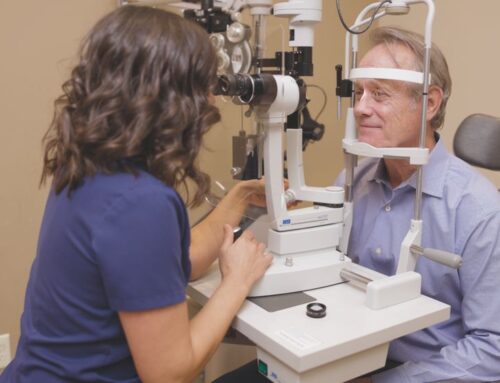By age 80, more than half of Americans either have a cataract or have undergone cataract surgery, according to the National Eye Institute. As cataracts become more common, one of the biggest decisions patients face is choosing between standard monofocal lenses or investing in multifocal lenses that promise clearer vision at multiple distances.
For many people, it raises the question: Are multifocal lenses worth it?
When comparing multifocal lens pros and cons, it becomes clear why patients are interested in this advanced technology. Multifocal intraocular lenses can reduce, or even eliminate, the need for glasses after cataract surgery, offering functional vision far beyond what basic monofocal lenses provide. But they also come with tradeoffs such as halos, glare, and slightly reduced contrast in certain lighting conditions.
This guide breaks down the benefits, downsides, ideal candidates, and real-world patient experiences so you can walk into your Reno cataract consultation fully prepared. If you’re wondering “Are multifocal lenses worth it?” this overview will help you make a confident, informed choice.
What Are Multifocal Cataract Lenses and How Do They Work?
Multifocal intraocular lenses are advanced, artificial lenses implanted during cataract surgery to replace the cloudy natural lens. What makes them unique is the way they bend and distribute light. Unlike standard lenses that have a single focal point, multifocal IOLs are designed with multiple rings or zones that focus light at different distances, near, intermediate, and far.
Here’s a simple comparison:
- Monofocal IOLs: One focal point, typically set for distance. Most patients still need reading glasses for smartphones, menus, or computer work.
- Multifocal IOLs: Multiple focal points, allowing more daily activities without glasses, though with potential visual side effects.
Types of advanced lenses offered at Eye Care Professionals include:
- Multifocal IOLs for near, intermediate, and distance vision
- Light Adjustable Lenses
- Trifocal lenses (such as PanOptix) for a broader focusing range
- EDOF lenses like Vivity for smoother distance–intermediate clarity
- Toric IOLs for patients with astigmatism
These options ensure that patients receive a customized solution based on their eyes and lifestyle.
What Are the Benefits of Multifocal Lenses?
What are the advantages of multifocal cataract lenses? When assessing multifocal intraocular lenses disadvantages/benefits, the strongest advantage is improved visual independence.
Reduced reliance on glasses
Studies consistently show that multifocal lenses provide significantly better uncorrected near vision than monofocals. More patients report complete or near-complete freedom from reading glasses, which is one of the strongest motivators for choosing them.
Clearer vision at multiple distances
Multifocal IOLs allow good distance vision but also functional intermediate and near vision. This makes everyday activities noticeably easier, such as:
- Driving or reading road signs
- Using a computer or tablet
- Reading a book, your phone, medication labels, or menus
Improved quality of life
Many patients describe a meaningful lifestyle upgrade when they no longer need to manage multiple pairs of glasses. Whether traveling, gardening, cooking, or playing sports, not relying on readers often makes the day feel more seamless.
Patient-focused benefits include:
- Reading your phone and labels more easily
- Switching between devices without changing glasses
- Enjoying hobbies and travel without visual inconvenience
- Long-term implant that won’t wear out like contacts or glasses
What Are the Downsides or Risks of Multifocal Lenses?
Understanding multifocal lens pros and cons also means acknowledging potential drawbacks. So, what are the problems with multifocal lenses?
Halos, glare, and starbursts
These lenses are more likely to produce visual disturbances, especially around headlights or streetlights at night. Modern trifocal lenses have improved significantly, and most people adapt well, but studies show 3–5% of patients find halos or glare severe or very bothersome.
Reduced contrast sensitivity
Multifocal lenses can slightly reduce how clearly you perceive contrast, such as gray-on-gray objects or dimly lit environments. Some patients notice it; others adapt quickly.
Out-of-pocket cost
When evaluating multifocal intraocular lenses disadvantages/benefits, cost is one of the biggest considerations. Because multifocal IOLs are considered “premium” technology, insurance typically only covers standard monofocal lenses. Patients often invest out-of-pocket costs for multifocals and associated testing.
Not everyone loves them
A small portion of patients experience ongoing visual dissatisfaction and may choose enhancements or, rarely, lens exchange. Proper screening reduces this risk significantly.
Who Is (and Isn’t) a Good Candidate for Multifocal Lenses?
Who is a good candidate for multifocal IOLs? The success of these lenses depends heavily on matching them to the right eyes and lifestyle.
Best candidates include:
- People who strongly want independence from glasses or contacts
- Individuals with healthy retinas, clear corneas, and no significant macular disease
- Patients comfortable with mild halos or reduced contrast in exchange for fewer glasses
- Active individuals who want vision that keeps up with work, hobbies, and travel
Not ideal for:
- Patients with macular degeneration, diabetic retinopathy, or advanced glaucoma
- People who drive long distances at night and dislike halos
- Individuals in very detail-critical professions (pilots, surgeons)
- Patients with very high expectations or low tolerance for visual side effects
Surgeons at Eye Care Professionals have extensive experience selecting the right lens for each patient based on lifestyle, goals, and ocular health. Proper evaluation ensures predictable outcomes and high satisfaction.
What Patients Are Saying About Multifocal Lenses
Most studies show that multifocal IOL patients report high satisfaction, especially due to their reduced dependence on glasses. Many enjoy the seamless ability to move between reading, computer work, and distance vision without switching eyewear.
Eye Care Professionals has been an early adopter of advanced lens technology in Northern Nevada, offering premium options including PanOptix, Light Adjustable Lenses, Vivity, and toric lenses. Their experience with advanced IOLs results in consistently strong outcomes.
Where to Get Multifocal Cataract Lenses in Reno, NV
Eye Care Professionals is recognized as a regional leader in advanced cataract surgery and premium lens technology. Patients benefit from:
- Multifocal, trifocal, EDOF, and toric IOL options
- Access to leading-edge technology, including LenSx laser cataract surgery
- iDESIGN refractive planning tools for highly personalized outcomes
- Surgeons who implant advanced IOLs at significantly higher rates than most practices, offering more patients state-of-the-art visual results
Still Wondering If Multifocal Lenses Are Worth It?
Cataract surgery today is a safe, routine procedure, and modern premium lens implants can dramatically sharpen your vision and restore day-to-day independence. Multifocal lenses are usually “worth it” for patients who care about reducing dependence on glasses and understand there may be some visual tradeoffs, like halos or glare in certain conditions.
Request a cataract evaluation with our Reno eye surgeons to discuss multifocal vs other lens options.











